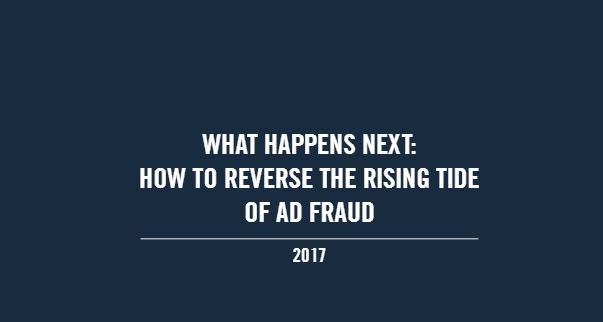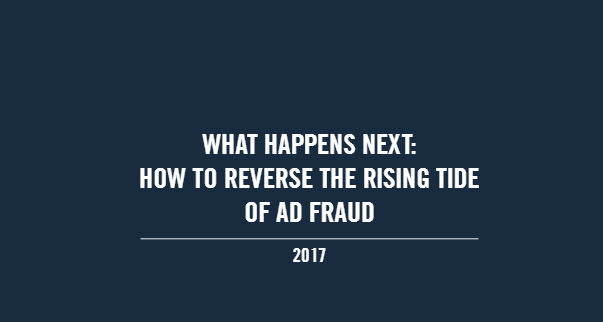
 The&Partnership, m/SIX and Adloox have published a report laying out the steps the industry needs to take to reverse the rising tide of advertising fraud – as new figures from Adloox suggest advertisers could be defrauded of $16.4bn in 2017.
The&Partnership, m/SIX and Adloox have published a report laying out the steps the industry needs to take to reverse the rising tide of advertising fraud – as new figures from Adloox suggest advertisers could be defrauded of $16.4bn in 2017.
The ‘What Happens Next: How to Reverse the Rising Tide of Ad Fraud’ report was commissioned by The&Partnership and m/SIX last year, and carried out over a period of 12 months by fraud detection specialists Adloox.
The study suggests the global cost of advertising fraud may until now have been significantly under-reported. Previously believed to cost advertisers $7.2bn globally each year[1], Adloox’s figures show the real cost of ad fraud may have been as high as $12.48bn in 2016 – accounting for almost 20% of the $66bn spent on digital advertising.
In 2017, if advertising expenditure grows to $80bn as forecast by eMarketer, and advertising fraud continues to evolve at its current rate, this figure may be set to rise to $16.4bn.[2]
“These figures serve as a stark reminder that much still remains to be done in order to protect and nurture the future vitality of the digital economy,” said The&Partnership Founder Johnny Hornby. “We have a duty to come together as an industry – from media agencies and industry bodies, to big-platform players like Google and Facebook; bringing in government help if we need it – in order to protect our own future and those of our clients.
“Good work is already being done by many, including the ANA, IAB, ISBA and the IPA, as well as the recent combined efforts of TAG (Trustworthy Accountability Group) in the US and JICWEB (the Joint Industry Committee for Web Standards) in the UK – but these new figures show that we need to move further, much faster. And there are concrete steps we should all be taking to make that happen.”
As a first step, Hornby called on media agencies to “invest time, energy and talent into providing the best possible strategies and policies to protect their clients.”
The&Partnership’s media agency m/SIX has since it was founded taken a specialist interest in advertising fraud, and has a policy of requiring all its clients to invest in specialist third-party, pre-bid ad verification such as that provided by Adloox – which has been shown to reduce the risk of fraudulent placements from 12-15% to 1-2%.
“Together with Adloox,” said Hornby, “we have reduced the average ad fraud score for clients including Vitality, JUST EAT, TalkTalk, Virgin Money and News UK down to just 0.4% – so it can be done. And it’s good to see many other reputable agencies have taken the same stance – refusing to buy media for their clients unless they have robust pre-bid ad verification policies in place.”
But, said Hornby, the responsibility doesn’t stop with agencies.
“Clients likewise need to be willing to get themselves off the drug of cheap digital media and invest in proper band protection. Pre-bid verification technology costs all of 3 pence per 1,000 impressions, accounting for about 2% of a brand’s overall media spend – but, for all the diligent clients out there, there are still plenty of others who are refusing to pay for it. If nothing else, this report proves what a false economy that is.
“Thirdly, and most importantly, the big-platform players like Google and Facebook need to step up to the plate and engage with initiatives like those launched by TAG and JICWEBS. They also need to put much better preventative measures in place to ensure that offensive and politically inflammatory content – beyond the wider debate about whether it should be published at all – is not and cannot become ad-enabled.
“Appearing in the ad space next to compromising content is hugely damaging for any brand and, by standing by and allowing it to happen, the big-platform media owners are neglecting their responsibility to do the right thing by the valuable customers who buy ad space with them.
“Finally, the time has come for the Googles and Facebooks to stop marking their own homework, and allow specialist, third-party auditors inside their walled gardens – to verify the viewability, non-human traffic and brand safety scores they send back to clients. Only then will we truly break the back of the ad fraud problem.”
Hornby will be appearing this morning at the Guardian’s Changing Media Summit, to discuss in more depth the steps the industry needs to take to combat advertising fraud – alongside Mark Finney, Director of Media & Advertising at ISBA, and Christian Armond, Head of Marketing at TUI.
The ‘What Happens Next’ report was conducted by Adloox across a robust 200bn daily bid requests and 10bn ad impressions per month, over a period of 12 months.
Marco Ricci, CEO of Adloox, said: “New, increasingly sophisticated types of ad fraud are popping up daily – and our investigation shows the importance of investing in specialist, robust brand protection.
“Advertising fraud is the bank robbery of the digital age – and it needs to be dealt with as such. Unless the industry takes concrete steps to combat it, it poses a serious threat to the future of our industry. Only through a combination of constant human vigilance, corporate diligence and constant updates to ad verification technologies will it be possible to reverse the rising tide, and put a stop to ad fraud once and for all.”
Adloox recently became the first European tech company to be accredited by the Media Ratings Council (MRC) for all general and advanced categories of invalid desktop traffic covered by the measurement watchdog.
Source:
1.According to the ANA’s ‘2014 Bot Baseline Report’.
2.Based on digital adspend growing to $80bn, as forecast by eMarketer, as well as the split between programmatic and publisher-direct buying shifting to a 50:50 balance. Currently, $27bn is spent on digital advertising through the programmatic exchange, while $39bn is spent through publisher-direct buying.
